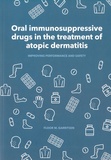Oral immunosuppressive drugs in the treatment of atopic dermatitis
Improving performance and safety

Garritsen, Floor
- Promoter:
- Carla Bruijnzeel-Koomen
- Co-promoter:
- Marjolein de Bruin-Weller & Marcel van den Broek
- Date:
- February 8, 2018
- Time:
- 14:30 h
Summary
In this thesis the treatment of atopic dermatitis (AD) by the use of oral immunosuppressive drugs is discussed in order to improve the performance and safety.
In the first part of this thesis we evaluated the qualitative and quantitative prescribing of oral immunosuppressive drugs in the Netherlands. In a ten year evaluation period in two academic centres, we found that cyclosporine A was given in 80% of the patients, mycophenolate mofetil or enteric-coated mycophenolate sodium in 31%, azathioprine in 14%, methotrexate in 11%, systemic glucocorticosteroids in 7% and systemic tacrolimus in 5%. In addition, we evaluated the prescribing behavior by using a pharmaceutical database and found that 1.4% of all AD patients used oral immunosuppressive drugs in the Netherlands between 2012-2017.
In the second part of this thesis open questions concerning safety of long-term treatment with oral immunosuppressive drugs in AD were answered. Lymphopenia was occasionally seen in AD patients treated with oral immunosuppressive drugs. Co-prescription of prednisone seemed to be a risk factor. Based on the results of this study, we suggest to monitor a leukocyte differentiation including the lymphocyte count, instead of only a white blood cell count, in AD patients using oral immunosuppressive drugs.
The risk of developing non-melanoma skin cancer in AD patients using oral immunosuppressive drugs was evaluated. We concluded that an increased risk of squamous cell carcinoma was found in this study, but that it is not clear whether this increased risk can be completely explained by the use of oral immunosuppressive drugs, because we found a lack of association between treatment duration and the risk of developing a tumor and a long interval between treatment discontinuation and the development of the tumor in some patients.
The occurrence of cervical carcinoma in women with AD treated with oral immunosuppressive drugs was not increased in our study population. We conclude that, as confirmed by the Dutch Guideline for cervix carcinoma, no intensified screenings program seems necessary for women with AD using oral immunosuppressive drugs. Finally, we performed a review of the existing literature in order to answer the question whether it is safe or not for men who wish to conceive, to continue their immunosuppressive treatment. Preterm birth, spontaneous abortion, low birth weight and congenital malformations have been described with a varying incidence. Therefore, a possible risk of adverse pregnancy of fetal outcomes when using these drugs cannot be excluded and patients should be aware of that.
In part three, we tried to optimize the therapeutic potential of thiopurines. We measured metabolite levels of azathioprine and concluded that for individual patients, routinely measuring 6-TGN and 6-MMP levels can be helpful in optimizing azathioprine dose, improving clinical effectiveness and preventing side effects. Co-prescription of allopurinol may optimize azathioprine treatment outcome in chronic eczema by increasing 6-TGN and decreasing 6-MMP levels. Finally, we concluded that thioguanine may be an alternative treatment option in patients with difficult to treat, severe AD who failed on azathioprine treatment.